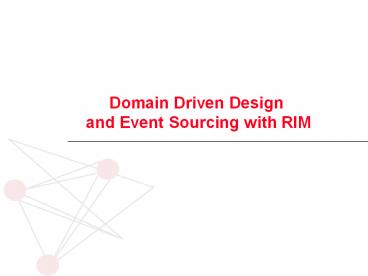Domain Driven Design and Event Sourcing with RIM - PowerPoint PPT Presentation
Title:
Domain Driven Design and Event Sourcing with RIM
Description:
Domain Driven Design and Event Sourcing with RIM * * * * * * * * * * Introduction * RIMResistance is Futile, you Will be Assimilated! DDD and Event Sourcing ... – PowerPoint PPT presentation
Number of Views:199
Avg rating:3.0/5.0
Title: Domain Driven Design and Event Sourcing with RIM
1
Domain Driven Design and Event Sourcing with RIM
2
Introduction
RIMResistance is Futile, you Will be Assimilated!
3
DDD and Event Sourcing
- Introduction
- George de la Torre
- Developer of custom clinical apps
- For a long time
- Discovered RIM a long time ago
- Oleg Sitalo (silent partner)
- Developer of custom clinical apps
- For a long time together
- Believes in RIM, at occasions
4
DDD and Event Sourcing
- Agenda
- Google will find heaps of stuff on this
- Will focus on the RIM stuff
- Great resources for DDD/ES
- http//msdn.microsoft.com/en-us/library/jj554200.a
spx - Implementing Doman-Driven Design
- Vaughn Vernon
- Domain Driven Design (the Blue Book)
- Eric Evans
5
DDD and Event Sourcing
- Domain Driven Design
- Object Oriented Model
- Business needs language captured
- HL7 v3 RIM benefits
- Design done! the hardest part
- Standard open shared to all
- Deep insights into domain knowledge
- Integration of domains built in (No barriers!)
- Reuse logic across clinical domains
6
Domain ModelBlueprint for all Aggregates
HL7 V3 RIM
7
Supporting DomainsExternal Services
Vocabulary
Bounded Contexts
8
Supporting DomainsExternal Services
Anti Corruption Layer
Other systems or Big Ball of Mud
Business Process and Rules Engines
Point This layer keeps RIM pure!
9
DDD and Event Sourcing
- Event Sourcing
- Only the Aggregate (D-MIM) is persisted
- The command is saved (Behavior)
- Aggregates publishes the events
- Command Query Responsibility Segregation (CQRS)
- Command (Transaction) Model
- Query Model
10
Patient Dashboard ExampleUse Case
- Schedule a patient visit
- Find Patient (Query Model)
- View Calendar (Query Model)
- Patient assigned time slot (Command)
- CreateAppointmentCommand(data) executes
- Scheduling aggregate is created from data
- The created aggregate is appended
- Publishes event to update Query Model
11
Scheduling AggregateExample
12
Scheduling AggregateCMET (PAT) is the Root
13
Scheduling Aggregate
- Considerations
- Entity is usually the Root
- No cloning, only class codes
- Aggregates varies with the RIM set
- Act may be the Root (Strategy)
- Reference others Aggregates (Observations)
- Act Mood partitioning
- PHI segregation requirement (Query model too)
- Performance
14
Scheduling Aggregate
- Considerations continued
- Serialized, XML, JSON, etc
- Relational Database (SQL)
- Cache based systems
- File systems
- NoSQL
- Natural for event stores
- Easier to query Aggregates if needed
- Aggregates loaded for logic on command
15
Scheduling AggregateAppended
CreateAppointmentCommand(data)
Event Store
ID Name Version Data
1 Schedule 1.2
2 Schedule 1.2
3 Schedule 1.2
16
Scheduling AggregatePublishes Events
AppointmentCreatedEvent(data)
UpdateDatabaseView()
Query model
MRN First Last DOB Phone Start End Note
17
Scheduling AggregatePublishes Events
AppointmentCreatedEvent()
CreateAdmissionMessage()
HL7 2.x
MSH\ADT1MCMLABADTMCM198808181126SECURITY
ADTA01MSG00001-P2.3 EVNA01198808181123 PID
PATID12345M11JONESWILLIAMAIII19610615M
-C1200 N ELM STREETGREENSBORONC27401-1020G
L(91-9)379-1212(919)271- 3434SPATID12345001
2M101234567899-87654NC
18
Scheduling AggregatePublishes Events
AppointmentCreatedEvent()
UpdateDataMart()
19
Patient Dashboard ExampleTwo Separate Models
(CQRS)
- Domain (Transaction) Model
- Complex structure (RIM)
- Aggregates are only created from RIM
- Aggregates are appended (Write Only)
- Query Model
- Simplified model structure (SQL)
- Multiple models created as needed
- Model optimized for querying (Read Only)
20
Simple Component DesignCQRS































